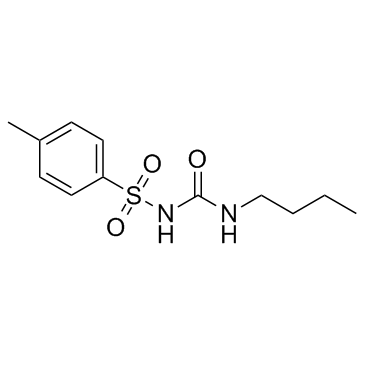Tolbutamide

Tolbutamide structure
|
Common Name | Tolbutamide | ||
|---|---|---|---|---|
| CAS Number | 64-77-7 | Molecular Weight | 270.348 | |
| Density | 1.2±0.1 g/cm3 | Boiling Point | 430.0±38.0 °C at 760 mmHg | |
| Molecular Formula | C12H18N2O3S | Melting Point | 128-130°C | |
| MSDS | Chinese USA | Flash Point | 213.9±26.8 °C | |
|
Cheminformatics analysis of assertions mined from literature that describe drug-induced liver injury in different species.
Chem. Res. Toxicol. 23 , 171-83, (2010) Drug-induced liver injury is one of the main causes of drug attrition. The ability to predict the liver effects of drug candidates from their chemical structures is critical to help guide experimental drug discovery projects toward safer medicines. In this st... |
|
|
Translating clinical findings into knowledge in drug safety evaluation--drug induced liver injury prediction system (DILIps).
J. Sci. Ind. Res. 65(10) , 808, (2006) Drug-induced liver injury (DILI) is a significant concern in drug development due to the poor concordance between preclinical and clinical findings of liver toxicity. We hypothesized that the DILI types (hepatotoxic side effects) seen in the clinic can be tra... |
|
|
The Japanese toxicogenomics project: application of toxicogenomics.
Mol. Nutr. Food. Res. 54 , 218-27, (2010) Biotechnology advances have provided novel methods for the risk assessment of chemicals. The application of microarray technologies to toxicology, known as toxicogenomics, is becoming an accepted approach for identifying chemicals with potential safety proble... |
|
|
Developing structure-activity relationships for the prediction of hepatotoxicity.
Chem. Res. Toxicol. 23 , 1215-22, (2010) Drug-induced liver injury is a major issue of concern and has led to the withdrawal of a significant number of marketed drugs. An understanding of structure-activity relationships (SARs) of chemicals can make a significant contribution to the identification o... |
|
|
A predictive ligand-based Bayesian model for human drug-induced liver injury.
Drug Metab. Dispos. 38 , 2302-8, (2010) Drug-induced liver injury (DILI) is one of the most important reasons for drug development failure at both preapproval and postapproval stages. There has been increased interest in developing predictive in vivo, in vitro, and in silico models to identify comp... |
|
|
Chemical genetics reveals a complex functional ground state of neural stem cells.
Nat. Chem. Biol. 3(5) , 268-273, (2007) The identification of self-renewing and multipotent neural stem cells (NSCs) in the mammalian brain holds promise for the treatment of neurological diseases and has yielded new insight into brain cancer. However, the complete repertoire of signaling pathways ... |
|
|
Air to lung partition coefficients for volatile organic compounds and blood to lung partition coefficients for volatile organic compounds and drugs.
Eur. J. Med. Chem. 43 , 478-85, (2008) Values of in vitro gas to lung partition coefficients, K(lung), of VOCs have been collected from the literature. For 44 VOCs, application of the Abraham solvation equation to log K(lung) yielded a correlation with R(2)=0.968 and S.D.=0.25 log units. Combinati... |
|
|
Inhibition of human aldehyde oxidase activity by diet-derived constituents: structural influence, enzyme-ligand interactions, and clinical relevance.
Drug Metab. Dispos. 43(1) , 34-41, (2014) The mechanistic understanding of interactions between diet-derived substances and conventional medications in humans is nascent. Most investigations have examined cytochrome P450-mediated interactions. Interactions mediated by other phase I enzymes are unders... |
|
|
Morphological behaviour and metabolic capacity of cryopreserved human primary hepatocytes cultivated in a perfused multiwell device.
Xenobiotica 45(1) , 29-44, (2014) 1. The quantitative prediction of the pharmacokinetic parameters of a drug from data obtained using human in vitro systems remains a significant challenge i.e. prediction of metabolic clearance in humans and estimation of the relative contribution of enzymes ... |
|
|
Evaluation of an electrochemical biosensor for uric acid measurement in human whole blood samples.
Clin. Chim. Acta 436 , 72-7, (2014) Uric acid measurement has become increasingly important, and electrochemically modified detection method based portable devices hold a dominant position in the market for point of care and self-monitoring of uric acid blood levels. However, there has been a l... |